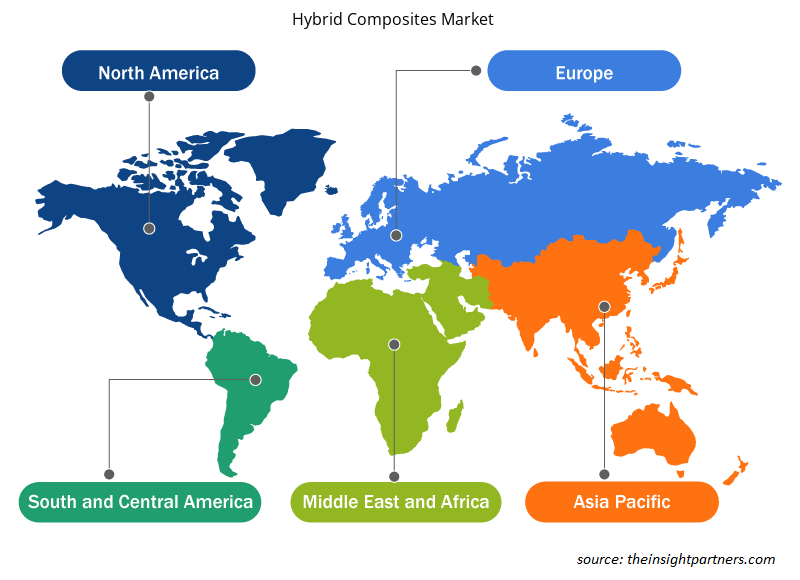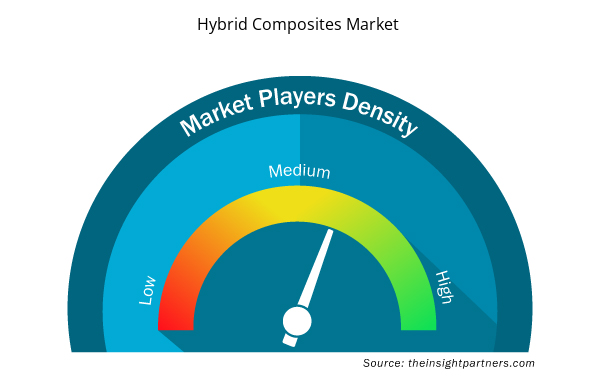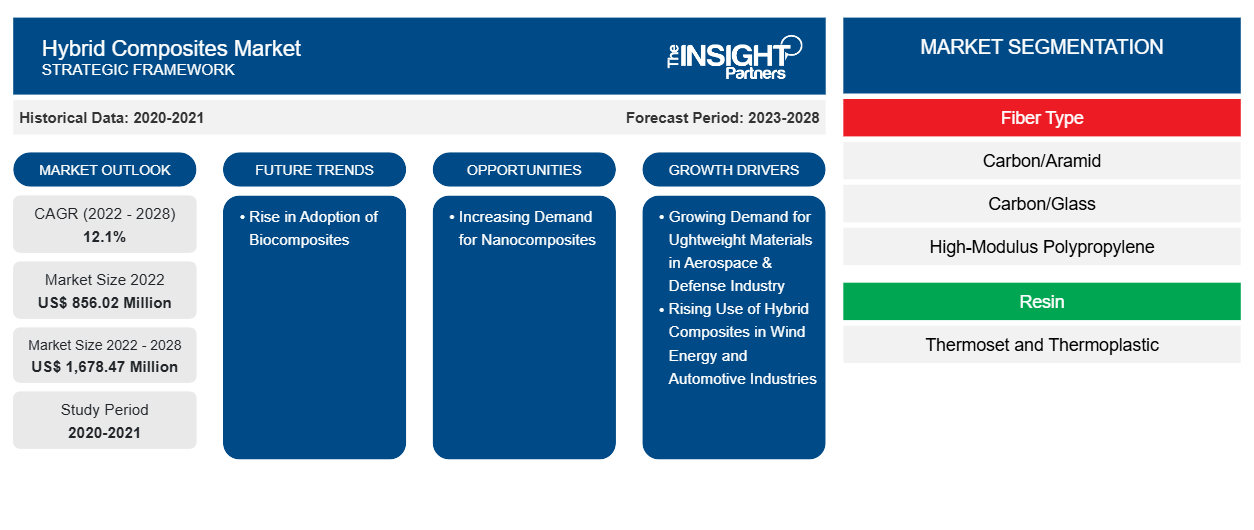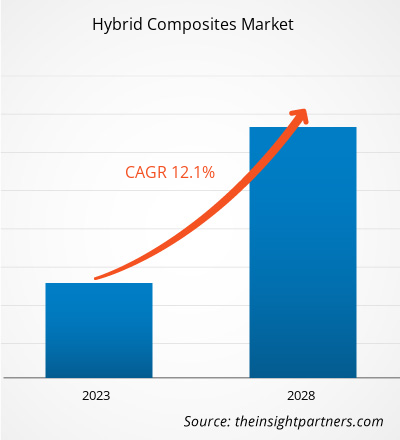[Informe de investigación] Se espera que el tamaño del mercado de compuestos híbridos crezca de US$ 856,02 millones en 2022 a US$ 1.678,47 millones en 2028; se estima que registrará una CAGR del 12,1% entre 2023 y 2028.
ANÁLISIS DE MERCADO
Los compuestos híbridos consisten en dos o más tipos de fibras incrustadas en una única matriz de polímero. Los compuestos híbridos se utilizan ampliamente en muchas aplicaciones de ingeniería, ofreciendo diversas propiedades mejoradas y ventajas sobre los materiales compuestos tradicionales. Los compuestos se utilizan para combinar las propiedades de diferentes tipos de fibras. Los compuestos híbridos más utilizados son el epoxi reforzado con carbono-aramida , que combina fuerza y resistencia al impacto, y el epoxi reforzado con vidrio-carbono, que proporciona un material resistente. Se utilizan en las industrias automotriz, aeroespacial, de energía eólica, marina, de artículos deportivos y otras. El mercado global de compuestos híbridos está segmentado en función del tipo de fibra, resina, aplicación y geografía.
IMPULSORES DEL CRECIMIENTO Y DESAFÍOS
Los compuestos híbridos son cruciales para la seguridad y el rendimiento eficiente de las aeronaves modernas. La creciente necesidad de materiales livianos para construir componentes y piezas de aviación ha aumentado significativamente la demanda de compuestos híbridos. Los fabricantes de aeronaves están haciendo esfuerzos para desarrollar enormes estructuras termoplásticas primarias en jets ejecutivos y aviones comerciales. Fueron los primeros en adoptar termoplásticos reforzados con fibras largas. Los materiales como los compuestos y los polímeros son significativamente más livianos que el acero, el latón, las aleaciones, el hierro, etc. El uso de estos materiales permite a los fabricantes reducir el peso de las piezas de los aviones, lo que facilita posteriormente la reducción de los costos de combustible. Por lo tanto, la creciente demanda de materiales livianos en la industria aeroespacial y de defensa está impulsando el crecimiento del mercado de compuestos híbridos. Sin embargo, la materia prima requerida para la fabricación de compuestos híbridos es cara, lo que hace que la producción secuencial de componentes sea desafiante y costosa. El costo de fabricación de las piezas de compuestos híbridos está significativamente influenciado por el tiempo del ciclo, que está fuertemente relacionado con el tiempo requerido para el llenado y el curado. Adaptar las propiedades de los compuestos híbridos requiere una colocación precisa y precisa del material a través de procesos de fabricación de compuestos, como el laminado manual o los procesos automatizados. Por lo tanto, se requiere una mano de obra calificada, que puede ser costosa en algunos casos. Por lo tanto, el alto costo de estos compuestos está restringiendo el crecimiento del mercado de compuestos híbridos.
Personalice este informe según sus necesidades
Obtendrá personalización en cualquier informe, sin cargo, incluidas partes de este informe o análisis a nivel de país, paquete de datos de Excel, así como también grandes ofertas y descuentos para empresas emergentes y universidades.
- Obtenga las principales tendencias clave del mercado de este informe.Esta muestra GRATUITA incluirá análisis de datos, desde tendencias del mercado hasta estimaciones y pronósticos.
SEGMENTACIÓN Y ALCANCE DEL INFORME
El informe "Pronóstico del mercado global de compuestos híbridos hasta 2030" es un estudio especializado y profundo que se centra principalmente en las tendencias y oportunidades de crecimiento del mercado global de compuestos híbridos. El objetivo del informe es proporcionar una descripción general del mercado global de compuestos híbridos con una segmentación detallada del mercado en función del tipo de fibra, resina, aplicación y geografía. El informe proporciona estadísticas clave sobre el consumo de compuestos híbridos en todo el mundo junto con su demanda en las principales regiones y países. Además, proporciona una evaluación cualitativa de varios factores que afectan el desempeño del mercado de compuestos híbridos en las principales regiones y países. El informe también incluye un análisis integral de los principales actores en el mercado de compuestos híbridos y sus desarrollos estratégicos clave. También se incluyen varios análisis sobre la dinámica del mercado para ayudar a identificar los factores impulsores clave, las tendencias del mercado y las oportunidades lucrativas del mercado de compuestos híbridos que, a su vez, ayudarían a identificar los principales bolsillos de ingresos.
Además, el análisis del ecosistema y el análisis de las cinco fuerzas de Porter proporcionan una visión de 360 grados del mercado global de compuestos híbridos, lo que ayuda a comprender toda la cadena de suministro y los diversos factores que afectan el crecimiento del mercado.
ANÁLISIS SEGMENTAL
El mercado global de compuestos híbridos está segmentado en función del tipo de fibra, resina y aplicación. Según el tipo de fibra, el mercado se segmenta en carbono/aramida, carbono/vidrio, polipropileno de alto módulo (HMPP)/carbono, polietileno de peso molecular ultraalto (UHMWPE)/carbono y otros. Según la resina, el mercado de compuestos híbridos se bifurca en termoestable y termoplástico. Según la aplicación, el mercado de compuestos híbridos se segmenta en automoción, aeroespacial, marino, energía eólica, artículos deportivos y otros.
Según el tipo de fibra, el segmento de carbono/aramida representó una importante participación en el mercado de compuestos híbridos en 2022. Los compuestos híbridos de carbono/aramida son materiales avanzados que combinan las propiedades deseables de la fibra de carbono y la fibra de aramida para crear un material único y de alto rendimiento. Las fibras de carbono son conocidas por su excepcional resistencia, rigidez y bajo peso, lo que las hace ideales para aplicaciones que requieren estructuras ligeras y de alto rendimiento. Las fibras de aramida, como el kevlar, poseen una resistencia al impacto excepcional, una excelente absorción de energía y una durabilidad notable.
El segmento de los termoendurecibles, basado en resinas, representó una importante participación en el mercado de los compuestos híbridos. Las resinas termoendurecibles se utilizan para fabricar la mayoría de los compuestos híbridos. Se convierten del estado líquido al sólido mediante polimerización o reticulación. Cuando se utilizan para producir productos terminados, las resinas termoendurecibles se curan mediante un catalizador, calor o una combinación de ambos.
Por aplicación, el segmento automotriz representó una importante participación en el mercado de compuestos híbridos. Los compuestos híbridos como el carbono y el vidrio, y el carbono y la aramida se utilizan en la fabricación de automóviles para reducir el peso del vehículo y cumplir con los estándares de kilometraje. Los compuestos híbridos se utilizan a menudo para producir paneles de carrocería y preparar bastidores de automóviles, llantas, resortes y revestimientos de cajas de camiones. Los fabricantes de vehículos también utilizan ampliamente los compuestos para aumentar la eficiencia del combustible y mejorar el rendimiento para transportar cargas útiles más grandes.
ANÁLISIS REGIONAL
El informe proporciona una descripción detallada del mercado global de compuestos híbridos con respecto a cinco regiones principales: América del Norte, Europa, Asia-Pacífico (APAC), Oriente Medio y África (MEA) y América del Sur y Central. Asia Pacífico representó la mayor participación de mercado de compuestos híbridos en 2022. En Asia Pacífico, China e India se encuentran entre los cinco principales países del mundo con energía eólica instalada. Los compuestos híbridos se utilizan cada vez más para aplicaciones de energía eólica. Asia Pacífico alberga importantes actores mundiales de semiconductores y automóviles, incluidos Samsung Electronics Co., Ltd.; Sony Group Corporation; SK Hynix Inc.; Toyota Motor Corporation; Tata Motors Ltd.; Hyundai Motor Company; Nissan Motor Co., Ltd.; y Honda Motor Co., Ltd. Estas empresas se centran en la expansión, la investigación y el desarrollo y la innovación de productos. Por lo tanto, los principales actores de semiconductores y automóviles de la región han aumentado la demanda de compuestos híbridos. Europa representó una parte significativa del mercado y se valoró en más de US$ 250 millones en 2022. La industria automotriz está creciendo significativamente en varios países de Europa. Según el informe de la Comisión Europea, la facturación generada por la industria del automóvil en Europa representa el 7% del PIB total de la región. Además, la presencia de importantes actores del sector automovilístico, como Volkswagen AG, Stellantis NV, Mercedes-Benz Group AG, Bayerische Motoren Werke AG y Renault SA, contribuye significativamente a la demanda de materiales compuestos híbridos en Europa.
DESARROLLOS DE LA INDUSTRIA Y OPORTUNIDADES FUTURAS
Las asociaciones, adquisiciones y lanzamientos de nuevos productos se encuentran entre las principales estrategias adoptadas por los actores que operan en el mercado global de compuestos híbridos.
- En 2022, Lanxess AG lanzó variantes de productos sostenibles para su gama de compuestos de la marca Tepex.
- En 2022, Avient Corporation adquirió DSM Protective Materials (marca Dyneema) y también anunció su plan de explorar opciones de venta para su negocio de distribución de Avient.
- En 2021, Solvay SA completó la instalación de su nueva planta de fabricación de compuestos termoplásticos (TPC).
Perspectivas regionales del mercado de composites híbridos
Los analistas de Insight Partners explicaron en detalle las tendencias y los factores regionales que influyen en el mercado de compuestos híbridos durante el período de pronóstico. Esta sección también analiza los segmentos y la geografía del mercado de compuestos híbridos en América del Norte, Europa, Asia Pacífico, Oriente Medio y África, y América del Sur y Central.

- Obtenga datos regionales específicos para el mercado de compuestos híbridos
Alcance del informe de mercado de materiales compuestos híbridos
| Atributo del informe | Detalles |
|---|---|
| Tamaño del mercado en 2022 | US$ 856,02 millones |
| Tamaño del mercado en 2028 | US$ 1.678,47 millones |
| CAGR global (2022-2028) | 12,1% |
| Datos históricos | 2020-2021 |
| Período de pronóstico | 2023-2028 |
| Segmentos cubiertos | Por tipo de fibra
|
| Regiones y países cubiertos | América del norte
|
| Líderes del mercado y perfiles de empresas clave |
|
Densidad de actores del mercado: comprensión de su impacto en la dinámica empresarial
El mercado de composites híbridos está creciendo rápidamente, impulsado por la creciente demanda de los usuarios finales debido a factores como la evolución de las preferencias de los consumidores, los avances tecnológicos y una mayor conciencia de los beneficios del producto. A medida que aumenta la demanda, las empresas amplían sus ofertas, innovan para satisfacer las necesidades de los consumidores y aprovechan las tendencias emergentes, lo que impulsa aún más el crecimiento del mercado.
La densidad de actores del mercado se refiere a la distribución de las empresas o firmas que operan dentro de un mercado o industria en particular. Indica cuántos competidores (actores del mercado) están presentes en un espacio de mercado determinado en relación con su tamaño o valor total de mercado.
Las principales empresas que operan en el mercado de compuestos híbridos son:
- Corporación Hexcel
- Lanxess AG
- SGL Carbono SE
- Gurit Holding AG
- Corporación Avient
Descargo de responsabilidad : Las empresas enumeradas anteriormente no están clasificadas en ningún orden particular.

- Obtenga una descripción general de los principales actores clave del mercado de compuestos híbridos
IMPACTO DE LA PANDEMIA DE COVID-19/IMPACTO DEL ESCENARIO GEOPOLÍTICO/IMPACTO DE LA RECESIÓN
La pandemia de COVID-19 provocó una disminución en el progreso de muchas industrias en todo el mundo. El cierre de las plantas de fabricación y el comercio restringido en todo el mundo provocaron restricciones en la cadena de suministro para los fabricantes globales. Las industrias automotriz, aeroespacial, marina, de energía eólica, de artículos deportivos y otras han contribuido en gran medida a la demanda de compuestos híbridos. En 2020, estas industrias tuvieron que ralentizar sus operaciones debido a las interrupciones en la cadena de valor causadas por las restricciones en las fronteras nacionales e internacionales. La escasez de mano de obra resultó en la desaceleración de la producción de compuestos híbridos. Las interrupciones en la cadena de suministro global y el cierre de las instalaciones de producción de compuestos híbridos habían afectado negativamente al crecimiento del mercado de compuestos híbridos. La industria automotriz es uno de los principales usuarios finales de compuestos híbridos. Durante la pandemia, la industria informó una reducción de la demanda, interrupciones del suministro, presión financiera y escasez de mano de obra.
En 2021, el mercado mundial comenzó a recuperarse de las pérdidas sufridas en 2020, ya que los gobiernos de diferentes países anunciaron la flexibilización de las restricciones sociales. Se permitió a los fabricantes operar a plena capacidad, lo que les ayudó a superar la brecha entre la oferta y la demanda. Además, el aumento de las tasas de vacunación generó entornos propicios para el progreso industrial. Esto ha dado lugar a una creciente demanda de compuestos híbridos por parte de diferentes industrias.
PANORAMA COMPETITIVO Y EMPRESAS CLAVE
Hexcel Corp, Lanxess AG, SGL Carbon SE, Gurit Holding AG, Avient Corp, Teijin Ltd, Solvay SA, PGTEX China Co Ltd, Toray Industries Inc y Mitsubishi Chemical Holdings Corp se encuentran entre los actores clave que operan en el mercado de compuestos híbridos.
- Análisis histórico (2 años), año base, pronóstico (7 años) con CAGR
- Análisis PEST y FODA
- Tamaño del mercado Valor/volumen: global, regional, nacional
- Industria y panorama competitivo
- Conjunto de datos de Excel


- HVAC Sensors Market
- Data Center Cooling Market
- Radiopharmaceuticals Market
- Industrial Valves Market
- Water Pipeline Leak Detection System Market
- Mesotherapy Market
- Adaptive Traffic Control System Market
- Dropshipping Market
- Resistance Bands Market
- Health Economics and Outcome Research (HEOR) Services Market

Report Coverage
Revenue forecast, Company Analysis, Industry landscape, Growth factors, and Trends

Segment Covered
This text is related
to segments covered.

Regional Scope
North America, Europe, Asia Pacific, Middle East & Africa, South & Central America

Country Scope
This text is related
to country scope.
Preguntas frecuentes
Ans. Europe is estimated to register the fastest CAGR in the global hybrid composites market over the forecast period. The increasing installed wind capacity and growing automotive, aerospace & defense industries in the region are driving the market growth.
The carbon/aramid segment held the largest share in the global hybrid composites market in 2022. Carbon/aramid hybrid composites are advanced materials that combine the desirable properties of carbon fiber and aramid fiber to create a unique and high-performance material.
In 2022, Asia Pacific held the largest share of the global hybrid composites market. In Asia Pacific, China and India are among the world’s top five countries with installed wind power. Hybrid composite is increasingly utilized for wind energy applications. Asia Pacific is home to significant automobile players across the world. The strong presence of the automotive industry in countries such as China, India, Japan, and South Korea is fueling the hybrid composites market growth in the region.
The thermoset segment held the largest share of the global hybrid composites market in 2022. Thermoset resins are utilized to make most hybrid composites. Thermoset hybrid composites are easy to produce as the liquid resin is easy to handle.
The key players operating in the global hybrid composites market include Hexcel Corp, Lanxess AG, SGL Carbon SE, Gurit Holding AG, Avient Corp, Teijin Ltd, Solvay SA, PGTEX China Co Ltd, Toray Industries Inc, and Mitsubishi Chemical Holdings Corp.
The projected growth of the market is attributed to the growing demand for lightweight materials in aerospace & defense industry and rising use of hybrid composites in wind energy and automotive industries.
Trends and growth analysis reports related to Chemicals and Materials : READ MORE..
The List of Companies - Hybrid Composites Market
- Hexcel Corp
- Lanxess AG
- SGL Carbon SE
- Gurit Holding AG
- Avient Corp
- Teijin Ltd
- Solvay SA
- PGTEX China Co Ltd
- Toray Industries Inc
- Mitsubishi Chemical Holdings Corp
The Insight Partners performs research in 4 major stages: Data Collection & Secondary Research, Primary Research, Data Analysis and Data Triangulation & Final Review.
- Data Collection and Secondary Research:
As a market research and consulting firm operating from a decade, we have published and advised several client across the globe. First step for any study will start with an assessment of currently available data and insights from existing reports. Further, historical and current market information is collected from Investor Presentations, Annual Reports, SEC Filings, etc., and other information related to company’s performance and market positioning are gathered from Paid Databases (Factiva, Hoovers, and Reuters) and various other publications available in public domain.
Several associations trade associates, technical forums, institutes, societies and organization are accessed to gain technical as well as market related insights through their publications such as research papers, blogs and press releases related to the studies are referred to get cues about the market. Further, white papers, journals, magazines, and other news articles published in last 3 years are scrutinized and analyzed to understand the current market trends.
- Primary Research:
The primarily interview analysis comprise of data obtained from industry participants interview and answers to survey questions gathered by in-house primary team.
For primary research, interviews are conducted with industry experts/CEOs/Marketing Managers/VPs/Subject Matter Experts from both demand and supply side to get a 360-degree view of the market. The primary team conducts several interviews based on the complexity of the markets to understand the various market trends and dynamics which makes research more credible and precise.
A typical research interview fulfils the following functions:
- Provides first-hand information on the market size, market trends, growth trends, competitive landscape, and outlook
- Validates and strengthens in-house secondary research findings
- Develops the analysis team’s expertise and market understanding
Primary research involves email interactions and telephone interviews for each market, category, segment, and sub-segment across geographies. The participants who typically take part in such a process include, but are not limited to:
- Industry participants: VPs, business development managers, market intelligence managers and national sales managers
- Outside experts: Valuation experts, research analysts and key opinion leaders specializing in the electronics and semiconductor industry.
Below is the breakup of our primary respondents by company, designation, and region:

Once we receive the confirmation from primary research sources or primary respondents, we finalize the base year market estimation and forecast the data as per the macroeconomic and microeconomic factors assessed during data collection.
- Data Analysis:
Once data is validated through both secondary as well as primary respondents, we finalize the market estimations by hypothesis formulation and factor analysis at regional and country level.
- Macro-Economic Factor Analysis:
We analyse macroeconomic indicators such the gross domestic product (GDP), increase in the demand for goods and services across industries, technological advancement, regional economic growth, governmental policies, the influence of COVID-19, PEST analysis, and other aspects. This analysis aids in setting benchmarks for various nations/regions and approximating market splits. Additionally, the general trend of the aforementioned components aid in determining the market's development possibilities.
- Country Level Data:
Various factors that are especially aligned to the country are taken into account to determine the market size for a certain area and country, including the presence of vendors, such as headquarters and offices, the country's GDP, demand patterns, and industry growth. To comprehend the market dynamics for the nation, a number of growth variables, inhibitors, application areas, and current market trends are researched. The aforementioned elements aid in determining the country's overall market's growth potential.
- Company Profile:
The “Table of Contents” is formulated by listing and analyzing more than 25 - 30 companies operating in the market ecosystem across geographies. However, we profile only 10 companies as a standard practice in our syndicate reports. These 10 companies comprise leading, emerging, and regional players. Nonetheless, our analysis is not restricted to the 10 listed companies, we also analyze other companies present in the market to develop a holistic view and understand the prevailing trends. The “Company Profiles” section in the report covers key facts, business description, products & services, financial information, SWOT analysis, and key developments. The financial information presented is extracted from the annual reports and official documents of the publicly listed companies. Upon collecting the information for the sections of respective companies, we verify them via various primary sources and then compile the data in respective company profiles. The company level information helps us in deriving the base number as well as in forecasting the market size.
- Developing Base Number:
Aggregation of sales statistics (2020-2022) and macro-economic factor, and other secondary and primary research insights are utilized to arrive at base number and related market shares for 2022. The data gaps are identified in this step and relevant market data is analyzed, collected from paid primary interviews or databases. On finalizing the base year market size, forecasts are developed on the basis of macro-economic, industry and market growth factors and company level analysis.
- Data Triangulation and Final Review:
The market findings and base year market size calculations are validated from supply as well as demand side. Demand side validations are based on macro-economic factor analysis and benchmarks for respective regions and countries. In case of supply side validations, revenues of major companies are estimated (in case not available) based on industry benchmark, approximate number of employees, product portfolio, and primary interviews revenues are gathered. Further revenue from target product/service segment is assessed to avoid overshooting of market statistics. In case of heavy deviations between supply and demand side values, all thes steps are repeated to achieve synchronization.
We follow an iterative model, wherein we share our research findings with Subject Matter Experts (SME’s) and Key Opinion Leaders (KOLs) until consensus view of the market is not formulated – this model negates any drastic deviation in the opinions of experts. Only validated and universally acceptable research findings are quoted in our reports.
We have important check points that we use to validate our research findings – which we call – data triangulation, where we validate the information, we generate from secondary sources with primary interviews and then we re-validate with our internal data bases and Subject matter experts. This comprehensive model enables us to deliver high quality, reliable data in shortest possible time.


 Obtenga una muestra gratuita de este informe
Obtenga una muestra gratuita de este informe